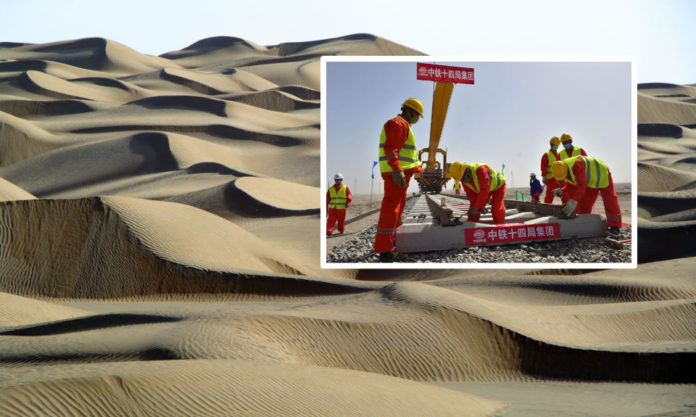The word “Taklamakan” is said to mean “Place of No Return”. That China is now embarking on the final section of a railway line that will encircle the entire desert, by 2022 it will be possible to turn that metaphor into reality.
Xinjiang, or to use its unwieldly full name, the Xinjiang Uyghur Autonomous Region, is translated literally as “New Frontier” (新疆). Considering its location, that moniker may ring true. For China and her ever expanding network of railways, thinking of Xinjiang as the final frontier may be more appropriate.
China Railway 14th Bureau Group (CRCC14) is responsible for project, as they are for many of China’s engineering challenges in the field of transportation. Indeed, CRCC14 has itself been busy in Nanjing recently, with the Jiajiang Tunnel project under the Yangtze that forms the southern approach to the Nanjing Number 5 Bridge.
The tunnel was a complicated effort indeed, as the boring machine came to within 80cm of the foundations for the Nanjing Eye observation platform. But by comparison to the 825 kilometre Ruoqiang to Hotan railway around the southern part of the Taklamakan Desert, it pales into insignificance.
In more plain terms, the Taklamakan is the size of Germany.
It’s an unforgiving environment; lying in the rain shadow of the Himalayas provides for a 60 degree Celcius difference in temperatures between winter and summer (-20 to 40 degrees). Despite this the Taklamakan almost devoid of water. The railway will link up many of the oasis towns that dot the sandy landscape, places on the Silk Road such as the long romanticised Kashgar that lies close to the the western end of the new rail link, close to the border with Afghanistan.
Given the vast barren nature of the terrain, it is no wonder Project Manager, Zhang Gang, revealed to told local media that CRCC14 has put in place a management and construction team with “rich experience in desert railway construction”, capable of working in and with the “intricate natural environment”, reported Railway Gazette on 21 May. They will need to be; working 24 hours a day, the team is expected to lay at least 2 kilometres of track per day.
As a single track line, the number of trains that will be able to run simultaneously shall be significantly curtailed. Only eight passenger trains will run each way per day, together with 15 million tonnes of freight per year. Running at speeds up to a maximum of 120 km/h, the trains shall stop at any or all of the 65 stations being built en route.
Hence we find this new line’s raison d’etre. As well as bringing much needed connectivity and economic development to local Xinjiang people, the line is yet another link in China’s increasingly famed Belt & Road Initiative.
Events of 2020 to date have also brought about considerable emphasis on domestic tourism. While The Nanjinger would not condone travelling to Xinjiang at the present time, industry insiders have said that the region could be back on the map for tourism later in the year. That said, travellers frequently encounter difficulties all across Xinjiang, largely on account of hugely varying travel policies.
When the time comes and the railway encircling the Taklamakan is in operation, the long trek from Nanjing will no doubt be worth it, if only for the opportunity for sightseeing of splendor beyond compare.









